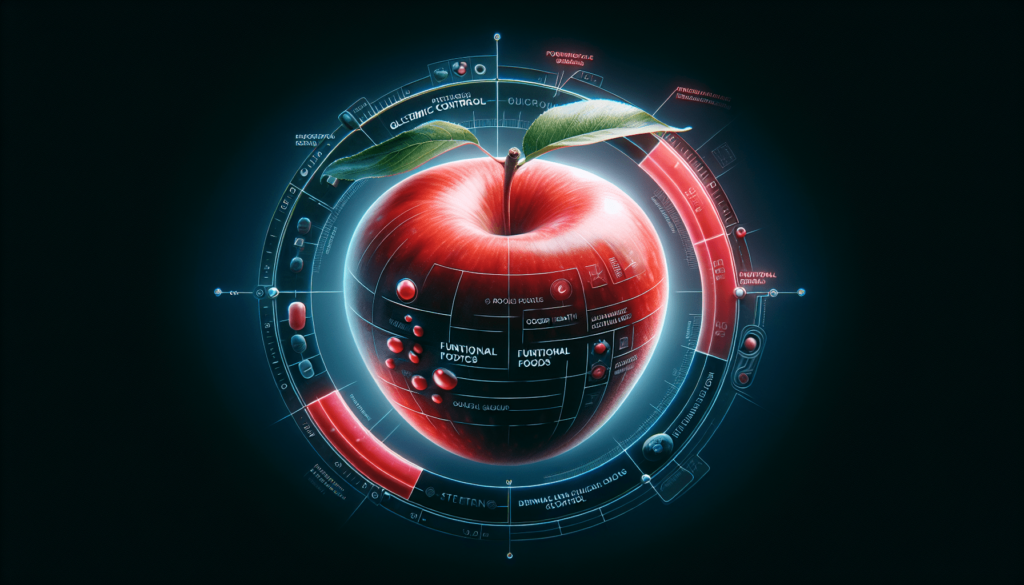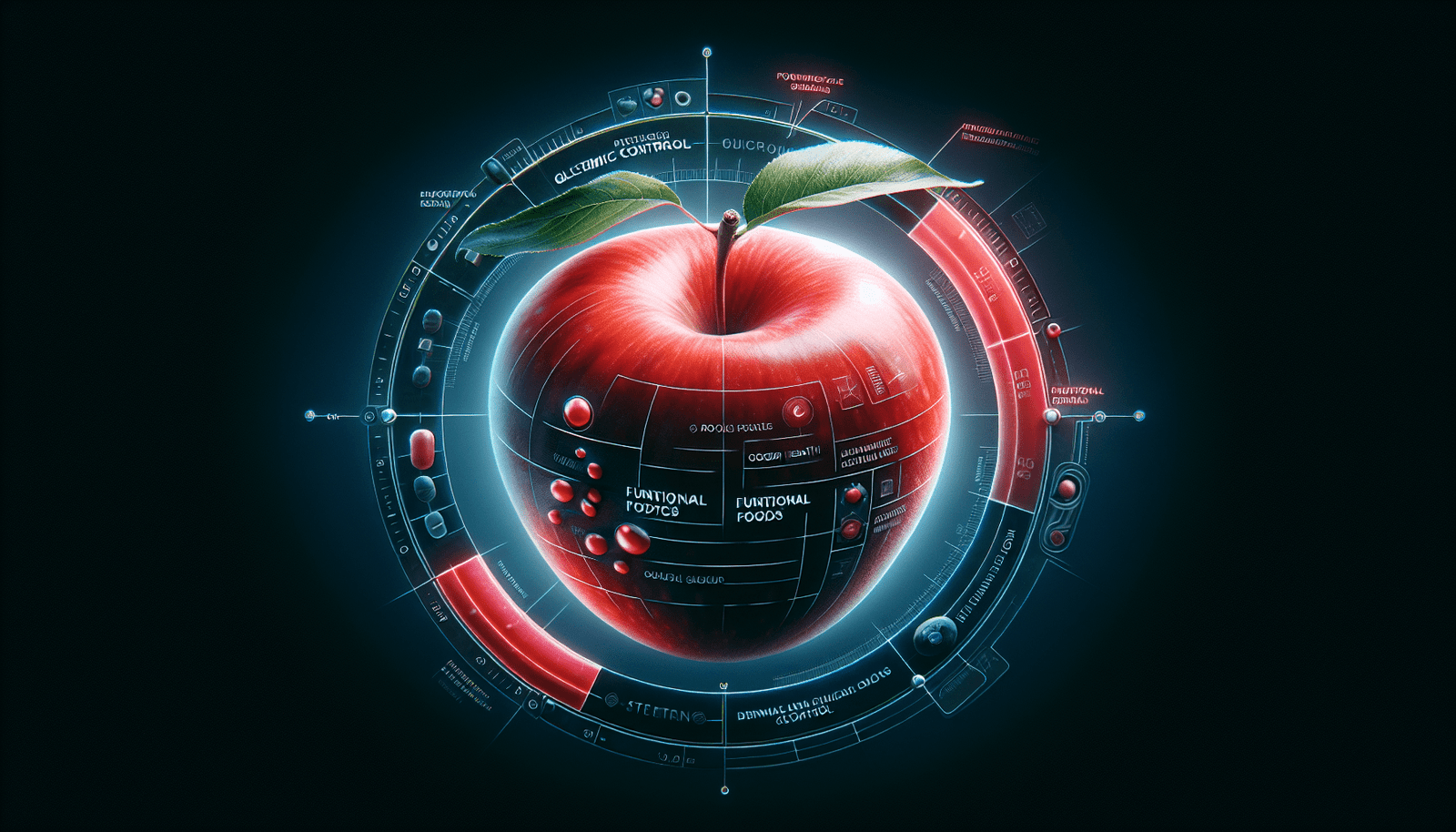Are you looking for a natural way to keep your blood sugar levels in check? If so, you may be interested to know that functional foods could be the answer you’ve been searching for. With their unique blend of beneficial ingredients, functional foods have been shown to have a positive impact on blood sugar control. From incorporating foods rich in fiber and antioxidants to including herbs and spices known for their blood sugar-lowering properties, these functional foods offer a delicious and effective way to manage your blood sugar levels. So, why not give them a try and see the difference they can make in your overall health and well-being?

What are functional foods?
Functional foods are a category of food that goes beyond basic nutrition and provides additional health benefits. These foods are intentionally modified or enhanced to improve their physiological functions and help manage specific health conditions. In the case of blood sugar management, functional foods can play a crucial role in regulating blood sugar levels and promoting overall health.
Definition of functional foods
Functional foods are defined as foods that contain bioactive compounds, such as fiber, omega-3 fatty acids, antioxidants, or specific nutrients, that have a positive effect on health beyond their basic nutritional value. These bioactive compounds interact with the body’s metabolic processes to provide additional health benefits, including the regulation of blood sugar levels.
Examples of functional foods
There is a wide variety of functional foods available, each offering unique health benefits. Some examples include:
- Berries: Berries, such as blueberries, strawberries, and raspberries, are rich in antioxidants and fiber, which help regulate blood sugar levels and lower the risk of developing chronic diseases like diabetes.
- Leafy greens: Vegetables like spinach, kale, and Swiss chard are packed with essential nutrients, including vitamins, minerals, and antioxidants, that can aid in blood sugar management.
- Fish: Fatty fish like salmon and sardines are excellent sources of omega-3 fatty acids, which have anti-inflammatory properties and can improve insulin sensitivity.
- Nuts and seeds: Almonds, walnuts, chia seeds, and flax seeds are examples of functional foods that provide healthy fats, fiber, and protein that can help stabilize blood sugar levels.
- Whole grains: Foods like quinoa, brown rice, and whole-wheat bread are rich in fiber and nutrients, making them better alternatives to refined grains for blood sugar management.
Understanding blood sugar levels
Before delving into the role of functional foods in blood sugar management, it’s important to understand what blood sugar levels are and their significance for overall health.
What are blood sugar levels?
Blood sugar, also known as blood glucose, refers to the amount of sugar present in your blood. It is the primary source of energy for your body’s cells and is derived from the food you consume. To maintain stable blood sugar levels, your body relies on the hormone insulin, which helps glucose enter cells for energy or storage.
Impact of high blood sugar levels
When blood sugar levels remain consistently high, it can lead to various health problems. For individuals with diabetes, high blood sugar levels can result from insufficient insulin production or the body’s inability to use insulin effectively. If left unmanaged, high blood sugar levels can lead to complications such as heart disease, kidney damage, nerve damage, and vision problems.
Importance of managing blood sugar levels
Managing blood sugar levels is essential for both individuals with diabetes and those at risk of developing the condition. By keeping blood sugar levels within a healthy range, it is possible to prevent or minimize the risk of associated health issues. This is where functional foods come into play.
Role of functional foods in managing blood sugar levels
Functional foods can have a significant impact on blood sugar levels due to their unique composition of nutrients and bioactive compounds. These foods can help regulate glucose absorption, improve insulin sensitivity, and prevent spikes in blood sugar levels after meals. By incorporating functional foods into your diet, you can better manage blood sugar levels and promote overall health.

Impact of functional foods on blood sugar levels
Functional foods play a crucial role in managing blood sugar levels by offering a combination of nutrients that promote stable glucose metabolism. These bioactive compounds work synergistically to regulate the release of glucose into the bloodstream and improve insulin sensitivity.
Types of functional foods for managing blood sugar levels
Functional foods that are particularly beneficial for managing blood sugar levels include those that are low on the glycemic index, high in fiber, rich in protein, and packed with omega-3 fatty acids or antioxidants.
Specific functional foods and their effects on blood sugar
Certain functional foods have been extensively studied for their specific effects on blood sugar levels. For instance, cinnamon has been shown to improve insulin sensitivity and reduce fasting blood sugar levels in individuals with diabetes. Similarly, turmeric has demonstrated anti-inflammatory properties that can help regulate blood sugar levels.
Mechanisms through which functional foods regulate blood sugar levels
Functional foods regulate blood sugar levels through various mechanisms. For example, fiber-rich foods slow down digestion and the release of glucose into the bloodstream, preventing sudden spikes in blood sugar levels. Omega-3 fatty acids promote insulin sensitivity and reduce inflammation, contributing to better blood sugar regulation. Antioxidants help protect pancreatic cells and promote healthy insulin production.
Functional foods with low glycemic index
Explanation of glycemic index
The glycemic index (GI) is a measure of how quickly and how much a food raises blood sugar levels after consumption. Foods with a low glycemic index release glucose slowly into the bloodstream, preventing abrupt spikes and promoting more stable and regulated blood sugar levels.
Benefits of consuming low glycemic index foods
Incorporating low glycemic index foods into your diet can be highly beneficial for blood sugar management. These foods provide a slower and more sustained release of glucose, resulting in improved blood sugar control, reduced insulin resistance, and increased satiety.
Examples of functional foods with low glycemic index
Some functional foods that have a low glycemic index include:
- Legumes: Lentils, chickpeas, and kidney beans are excellent sources of fiber, protein, and essential nutrients, making them ideal for promoting stable blood sugar levels.
- Quinoa: This whole grain contains complex carbohydrates and is rich in fiber, making it an excellent choice for maintaining healthy blood sugar levels.
- Sweet potatoes: With their lower glycemic index compared to regular potatoes, sweet potatoes provide a good source of complex carbohydrates and fiber.
- Greek yogurt: Rich in protein and low in carbohydrates, Greek yogurt offers a satisfying snack option that won’t cause significant blood sugar spikes.
- Nuts: Almonds, pecans, and macadamia nuts have a low glycemic index and provide healthy fats, fiber, and protein.
Fiber-rich functional foods
Role of fiber in managing blood sugar levels
Fiber is an essential component of a balanced diet, and when it comes to blood sugar management, its role is particularly noteworthy. Soluble fiber, found in foods such as oats, legumes, and some fruits and vegetables, forms a gel-like substance in the digestive tract that slows down the absorption of glucose, preventing rapid spikes in blood sugar levels.
Benefits of consuming fiber-rich functional foods
Incorporating fiber-rich functional foods into your diet can have several advantages for blood sugar management. Firstly, dietary fiber can help control post-meal blood sugar spikes by regulating the release of glucose into the bloodstream. Secondly, fiber-rich foods tend to be more filling and can contribute to a sense of satiety, aiding in portion control and weight management.
Examples of fiber-rich functional foods
Some functional foods that are rich in fiber include:
- Chia seeds: These tiny seeds swell up when soaked and form a gel-like substance, making them an excellent source of soluble fiber.
- Broccoli: Besides being a great source of vitamins and minerals, broccoli contains fiber that supports healthy blood sugar levels.
- Whole-grain bread: Opting for whole-grain bread instead of its refined counterpart ensures a higher intake of fiber.
- Apples: This versatile fruit is packed with fiber and can help regulate blood sugar levels.
Protein-rich functional foods
Impact of protein on blood sugar levels
Protein is an essential nutrient that plays a vital role in blood sugar management. When consumed, protein helps slow down the digestion and absorption of carbohydrates, leading to a more controlled release of glucose into the bloodstream. This helps prevent sudden blood sugar spikes and promotes a more stable energy supply.
Benefits of consuming protein-rich functional foods
Incorporating protein-rich functional foods into your diet can offer several benefits for blood sugar management. Firstly, consuming protein can lead to increased satiety and reduced appetite, assisting in portion control and weight management. Secondly, protein-rich foods have a minimal impact on blood sugar levels compared to foods high in carbohydrates alone.
Examples of protein-rich functional foods
Some functional foods that are excellent sources of protein include:
- Greek yogurt: This creamy and satisfying yogurt is not only low in carbohydrates but also high in protein.
- Quinoa: Apart from being a fiber-rich food, quinoa is also a notable source of plant-based protein.
- Lentils: With a high protein content, lentils provide a nutritious option for blood sugar management.
- Eggs: Eggs are a versatile and protein-packed functional food that can be enjoyed in various ways.
Rich sources of omega-3 fatty acids
Effects of omega-3 fatty acids on blood sugar levels
Omega-3 fatty acids are a type of polyunsaturated fat that offers numerous health benefits, including their potential to help manage blood sugar levels. These essential fatty acids have been shown to improve insulin sensitivity, reduce inflammation, and enhance overall metabolic health.
Benefits of consuming omega-3 fatty acids
Incorporating omega-3 fatty acids into your diet can have several advantages for blood sugar management. Research suggests that these fatty acids can lower fasting blood sugar levels, improve insulin sensitivity, and reduce the risk of developing type 2 diabetes. Additionally, omega-3 fatty acids have been found to have cardio-protective effects and promote optimal brain function.
Examples of functional foods rich in omega-3 fatty acids
Some functional foods that are rich sources of omega-3 fatty acids include:
- Fatty fish: Salmon, mackerel, and sardines are excellent sources of omega-3 fatty acids, making them ideal additions to a blood sugar-friendly diet.
- Chia seeds: In addition to their fiber content, chia seeds are also abundant in omega-3 fatty acids.
- Flaxseeds: These tiny seeds are packed with omega-3 fatty acids and can be easily incorporated into smoothies, cereals, or baked goods.
Antioxidant-rich functional foods
Role of antioxidants in managing blood sugar levels
Antioxidants are compounds that help protect the body from oxidative stress and damage caused by harmful free radicals. When it comes to blood sugar management, antioxidants can play a crucial role by reducing inflammation, enhancing insulin sensitivity, and promoting healthy glucose metabolism.
Benefits of consuming antioxidant-rich functional foods
Incorporating antioxidant-rich functional foods into your diet can have numerous benefits for blood sugar management. Antioxidants help protect pancreatic cells, which produce insulin, thereby promoting healthy insulin levels. Additionally, antioxidant-rich foods contribute to overall cellular health, potentially reducing the risk of developing chronic diseases associated with high blood sugar levels.
Examples of antioxidant-rich functional foods
Functional foods that are rich in antioxidants include:
- Berries: Blueberries, strawberries, and raspberries are renowned for their antioxidant content and potential blood sugar-regulating properties.
- Dark chocolate: Dark chocolate with a high cocoa content provides antioxidants like flavonoids that may positively influence blood sugar levels.
- Green tea: Rich in catechins, green tea has been associated with improved insulin sensitivity and blood sugar control.
Functional foods and portion control
Importance of portion control in blood sugar management
Portion control plays a significant role in blood sugar management. Consuming large portions of food, even if it consists of functional foods, can still lead to spikes in blood sugar levels. It’s essential to maintain a balance and moderate the serving sizes of functional foods to ensure their optimal benefits.
How functional foods aid in portion control
Functional foods can aid in portion control through their nutrient composition. High-fiber foods, for example, tend to be more filling, which can help reduce excessive calorie intake. Protein-rich functional foods also contribute to satiety, making it easier to control portion sizes and prevent overeating.
Strategies for incorporating functional foods into portion-controlled meals
To incorporate functional foods into portion-controlled meals, consider the following strategies:
- Fill half your plate with non-starchy vegetables, which are low in calories and high in nutrients.
- Use functional foods as toppings or additions to meals, such as adding berries to a salad or incorporating flaxseeds into a smoothie.
- Opt for small serving sizes of high-fiber or protein-rich functional foods to include them as part of a balanced meal.
- Pay attention to portion sizes for foods that may have calories or carbohydrates, such as nuts, as they can contribute to overall calorie intake.
- Consult with a healthcare professional or dietitian to create a personalized portion-controlled meal plan that incorporates functional foods for blood sugar management.
Integration of functional foods into a healthy diet
Building a balanced diet with functional foods
Building a healthy and balanced diet involves incorporating functional foods alongside a variety of other nutrient-rich foods. Functional foods can complement other healthy eating principles, such as consuming adequate fruits and vegetables, whole grains, lean proteins, and healthy fats.
Tips for incorporating functional foods into daily meals
To make the most of functional foods, consider implementing the following tips:
- Experiment with new recipes that incorporate a variety of functional foods.
- Create meal plans that include a balance of functional foods from different categories, such as fruits, vegetables, lean proteins, and whole grains.
- Be mindful of portion sizes to ensure you’re getting the benefits of functional foods without excessive calorie intake.
- Learn about the nutritional properties of different functional foods and how they can fit into different meals and snacks throughout the day.
- Consider keeping a well-stocked pantry with functional food options to make it easier to incorporate them into meals.
Considerations when selecting functional foods
When selecting functional foods, it’s important to consider various factors. These include individual dietary needs, preferences, and any specific health conditions or medications. It may be beneficial to consult with a healthcare professional or registered dietitian for personalized advice on incorporating functional foods into your diet and managing blood sugar levels effectively.
In conclusion, functional foods play an integral role in managing blood sugar levels and promoting overall health. By incorporating a variety of functional foods into a balanced diet, individuals can support stable blood sugar levels, improve insulin sensitivity, and reduce the risk of developing diabetes or associated complications. Whether it’s low glycemic index foods, fiber-rich options, protein-packed choices, omega-3 fatty acids, or antioxidant-rich foods, there is a wealth of functional foods available to support blood sugar management. Remember to prioritize portion control, experiment with recipes, and seek personalized guidance when incorporating functional foods into your diet. By doing so, you can harness the power of functional foods to optimize your health and well-being.
